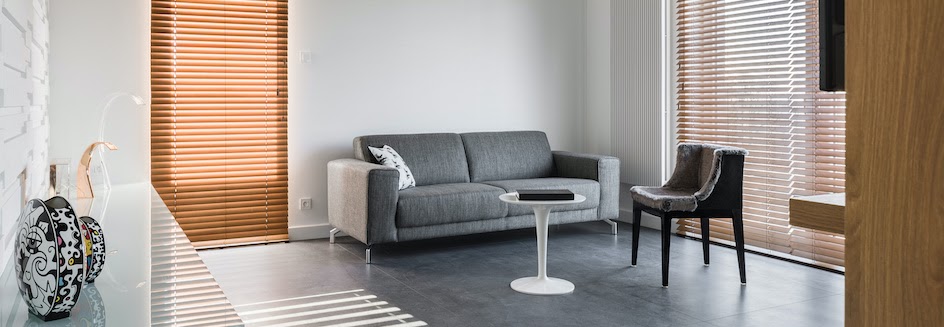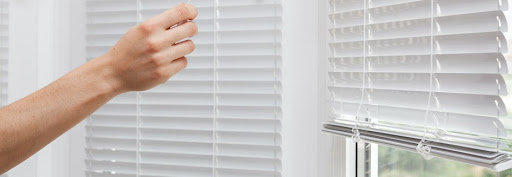Horizontal blinds are the little black dress of window treatments. They never go out of style, and they look just as good at a dinner party (i.e., in your dining room) as they do during a romantic night in (i.e., in your living room, bedroom or wherever you want to snuggle up).
Also called Venetian blinds, horizontal blinds have been popular in the UK since at least the 1760s. And these blinds stand the test of time in more ways than one. Yes, venetian blinds offer enduring style, but they're also a sturdy choice.
So, will this sturdy blind stand up to your needs? Take a look at the advantages and disadvantages of horizontal blinds to decide if your widows have met their match.
What To Expect From Horizontal Blinds
Wooden blinds are made with a series of horizontal slats that hang one on top of the other from a ribbon or cord. They're attached to the top of your window frame via a headrail, which is a slim metal box that hides the inner working of your blinds — all the bits and bobs that make the blinds go up and down.
Generally, your blinds will feature two sets of cords that hang from the headrail: a control cord and a tilt cord. (Although, some models will use a wand in place of the tilt cord.) The control cord allows you to open and close your blinds while the tilt cord allows you tilt the slats so that, even when your blinds are drawn, you can still let light in.
There are also cordless window treatments, like plantation shutters or cellular shades, that offer a similar look to venetian blinds but function differently.
Plantation shutters feature horizontal slats attached to a central dowel rod. Like the tilt cord, the dowel rod allows you to tilt the slats and let light in, but this window treatment cannot be drawn open like horizontal blinds. Instead, the shutters open outward like a door, which means you have to keep your home furnishings out of the way.
Cellular shades open just like horizontal blinds, but they're made from a single pleated material instead of individual slats. These blinds tend to be less durable than high-quality horizontal blinds.
Safety is the main reason homeowners look for cordless window blinds, but corded blinds can be just as safe. You can't put a price on peace of mind, so make sure the treatment you choose comes with built-in child-safety features. (These come standard on all our blinds at Make My Blinds, because we have kids too.)
Safety comes first, but it's not the only benefit of horizontal window blinds. There are lots of reasons to love this window treatment in your home.
4 Advantages of Horizontal Blinds
We already know that horizontal blinds are timeless, durable and safe. But, let's be honest, you'd expect that from any window shades you'd choose. Here are the finer details that set these blinds apart.
1. They Provide Superior Light Control
The slats on horizontal blinds allow you to direct light, not just block it out. If you close the slats completely, the blinds provide effective room darkening, blocking out 90-95% of the light. You can also direct the slats up or down for the perfect combination of privacy and light filtering.
In the bedroom, you can aim the slats up at the ceiling to allow morning light to filter in without getting in your eyes. And in the kitchen, you can direct your blinds down at your countertops so you can see what you're working on without being blinded by the afternoon sun.
2. They're Easy To Open and Close
With the pull of a string, you can draw your blinds and direct the light. This is faster than vertical blinds and draperies, which can stick as you draw them open. It's also faster than roller blinds, which require a few tugs on their pulley system.
3. They're Available in a Variety of Materials and Styles
You can find plastic, aluminium and wood venetians. Wooden and faux wooden blinds come in white, grey and wood tones to match your home decor. With aluminium venetian blinds, you can find a variety of colours — from taupe to turquoise — to provide a perfect accent to any room.
The horizontal slats also come in different sizes. The slats on wooden blinds range from 30-55 millimetres, while aluminium mini blinds feature 25 millimetre slats. The bigger the slats, the more room darkening the blinds will provide. Wooden blinds are also available with decorative tape and a matching valance to cover the headrail.
4. They Suit Most Windows and Rooms
Horizontal blinds are traditionally used for tall, thin windows, but they can be fitted to windows as wide as 240 centimetres, which means they suit most windows in the house.
If you want to install horizontal window blinds in a high-moisture room, like the kitchen or bathroom, avoid real wood (it can warp), and opt for faux wood or aluminium blinds instead. Similarly, the heat in your conservatory can warp real or faux wood blinds, so look for aluminium venetians if you're fitting windows in that room.
Horizontal blinds are ideal for bay windows because you can have one panel of blinds fitted to each window pane.
For bifold doors, french doors or patio doors, Perfect Fit blinds can sit inside the door frame. This will keep the blinds from banging each time you open or close the door.
3 Disadvantages of Horizontal Blinds
Horizontal blinds are probably sounding pretty good right now, but don't go into your purchase blind. Here are a few reasons that this window treatment — no matter how beautiful it is — may not be right for your space.
1. They Take Longer To Clean
Dust can collect on the slats of your horizontal blinds, and you'll have to clean each slat individually. Just take a damp cloth and wipe each slat down.
For easier cleaning, opt for roller shades. You can wipe these down in a single motion.
2. They Don't Fit All Windows and Doors
If you have a sliding door, horizontal blinds will get in the way. Look for vertical blinds instead. Vertical blinds are also a better choice for windows that open to the side instead of up and down.
And vertical blinds are better suited to extremely wide windows because a vertical blind track can run the width of the entire window. If you still prefer the look of horizontal blinds and have a window that's wider than 240 centimetres, you can install two or more panels of horizontal blinds side by side. But if you go this route, a small amount of light may creep in where the two panels meet.
3. They Don't Block All the Light
While horizontal blinds provide room darkening and the best light control, they're not blackout blinds. If you're someone who needs total darkness to sleep, consider an alternative window treatment for your bedroom.
Vertical blinds, roller blinds and roman blinds are all available with blackout linings.




